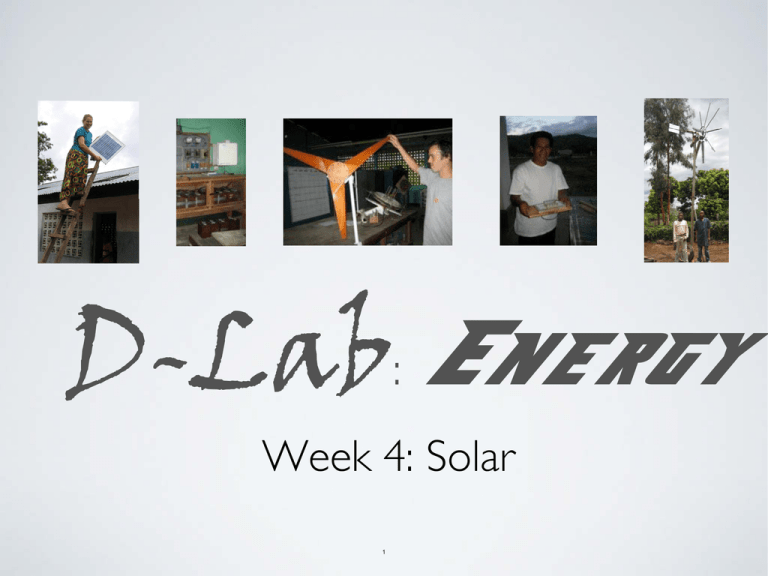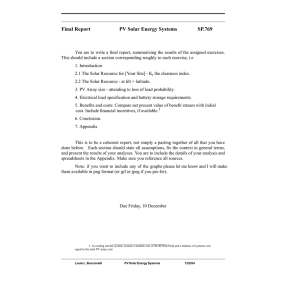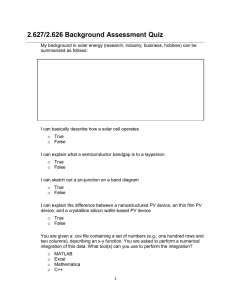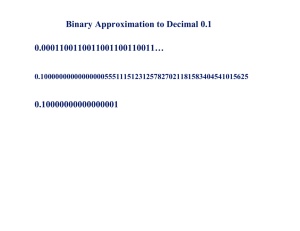
D-Lab: Energy
Week 4: Solar
1
Estimation
How big a solar panel do you need to power a
100W incandescent light bulb?
2
Solar Rules of Thumb
solar flux: 1
2
kW/m
PV efficiency (best case): 10-20%
2
➠ 100 W/m
3
Solar Options
SODIS: water disinfection
Solar Thermal
cooking/drying
water heating
generating electricity
PV: generating electricity
4
Solar drying
Fruits of the Nile - Uganda
© Ashden Awards, photos by Anne Wheldon. All rights reserved. This content is excluded from our Creative Commons license. For more information, see http://ocw.mit.edu/fairuse.
http://www.fullwellmill.co.uk/partners/fon.htm
5
© source unknown. All rights reserved. This content is excluded from our Creative
Commons license. For more information, see http://ocw.mit.edu/fairuse.
Solar Thermal Panels
for water heating
6
Courtesy of Southface Energy Institute. Used with permission.
Source: http://www.southface.org/learning-center/library/solar-resources/how-solar-thermal-works.
7
Luz Project in Mojave Desert, CA
largest solar thermal-electric installation in the world
350MW peak output
© source unknown. All rights reserved. This content is excluded from our Creative
Commons license. For more information, see http://ocw.mit.edu/fairuse.
generates high-temperature steam using arrays of concentrating
mirrors. steam powers a turbine that drives a generator to
produce electricity
8
Matthew Seitzler, M.S., E.I.T.
www.SRE-Engineering.com
9
Courtesy of Matthew Seitzler. Used with permission.
Light is converted to
electricity via photovoltaic
effect in silicon.
Materials have difference
eff. and costs.
3-25% of light is
converted directly into
electricity.
Dependent on the
intensity of light normal to
the surface of the module.
10
Courtesy of Matthew Seitzler. Used with permission.
Many photovoltaic materials, all
wil pros and cons
crystalline silicon
◦ monocrystalline
◦ polycrystalline
◦ multicrystalline
◦ ribbon silicon
amorphous silicon
cadmium telluride
copper indium selenide/sulfide
organic cells
11
12
Solar cells (~0.5V) are wired together to
obtain module (panel) voltage (5-31V).
Modules are wired together depending
on solar electric system type to form
array (15-1000V).
Module power values include efficiencies.
Sensitive to temperature.
12
Section of 200 W Solar
Module
Courtesy of Matthew Seitzler. Used with permission.
Series vs. Parallel Wiring
SERIES
PARALLEL
SERIES/PARALLEL
12 Volts @ 350 Amp hours.
6 Volts @ 700 Amp hours.
© source unknown. All rights reserved. This content is excluded from our Creative
Commons license. For more information, see http://ocw.mit.edu/fairuse.
13
12 Volts @ 700 Amp hours.
14
Typical Components:
Solar Panel or Module
(3-20%)
Solar Regulator or
Charge Controller
(90-95%)
Battery (80%)
Power Inverter (90-97%)
DC Disconnect
Fuses
Stand-alone PV system components
14
Courtesy of Matthew Seitzler. Used with permission.
Grid-tied PV systems
Stand alone or autonomous systems
Hybrid PV
15
Courtesy of Matthew Seitzler. Used with permission.
Stand alone systems
Direct or stored PV energy
possible
System is completely
autonomous i.e. not
connected to an electric
grid
Like a mini-grid
Lower system voltages
Typically deployed in rural
16
Courtesy of Matthew Seitzler. Used with permission.
Islanding (Hybrid)
systems
Connected to the
utility grid
Battery bank
used to store
energy
Energy from
battery bank fed
to grid
Uses lower array
voltages
17
Courtesy of Matthew Seitzler. Used with permission.
Bangladesh stand-alone PV
system
Masdar 10 MW Solar array
18
Courtesy of Matthew Seitzler. Used with permission.
19
Courtesy of Matthew Seitzler. Used with permission.
Problem:
Can I power my small 110 volt AC 75 watt
refrigerator for three hours during a day with 5 sun
hours using a 12 volt, 100 amp hour battery and a
100 watt solar module?
To prevent destroying the battery I do not want
to go lower than 70% discharge.
Assume system efficiencies of 80% for the
battery conversion, 95% charge controller, 95%
for the inverter.
What type of system is this?
20
Courtesy of Matthew Seitzler. Used with permission.
Tools:
Ohm’s Law:
Voltage (V) = Current (I)*Resistance (R)
Electrical Power Equation:
Power (P) = Current (I)*Voltage(V)
Solar Energy International PV Design Manual
Friends in PV.
21
Courtesy of Matthew Seitzler. Used with permission.
I. Resource Estimation
Known:
100 watt[1] module, 5 sun hours per day
Calculate Resource:
Energy = 100 W*5 hrs/day =500 Whrs/day
Include Charge Controller Eff.:
Energy = 500 Whrs/day*0.95 = 475 Whrs/day
22
1. Nominal value (Pnom) from
manufacturer for standard testing
conditions.
Courtesy of Matthew Seitzler. Used with permission.
II. Load Determination
Known:
75 W frig, 3 hours per day
Calculate Load:
Load = 75 W*3 hrs/day =225 Whrs/day
Calculate Load with inverter eff.:
[2]
Load = 225 Whrs/day/0.95 = 236 Whrs/day
Note: Inverter size should be 1.25 times surge load for frig.
2. Eff. in devisor because of load or
demand side computation.
23
Courtesy of Matthew Seitzler. Used with permission.
III. Energy Storage
Known:
100 Amp*hr battery, 80% eff., with 70%
allowable discharge
Calculate Storage Capacity:
1. Convert to kWhrs
100 Amp*hrs*12 Volts =1200 Whrs
2. Include eff. & allowable discharge
1200 Whrs*0.70*0.80 = 672 Whrs*
24
*Estimated value not including
battery degradation overtime.
Courtesy of Matthew Seitzler. Used with permission.
IV. Energy Balance
Known:
Resource = 475 Whrs/day
Load = 236 Whrs/day
Resource side:
• Resource > Load ? Yes, Load is only ~50% of
Resource
Storage side:
• Storage > Load ? Yes, Load is only ~35% of
Resource
25
Courtesy of Matthew Seitzler. Used with permission.
IV. Limit Calculations
Days of Autonomy (Dauto):
• Dauto = Storage/Load
Dauto= 672 Whr/ 236 Whr/day =~ 2.8 days
Days to charge battery (Dbat):
• Dbat = Storage/Resource
Dbat = 672 Whr/472 Whr/day =~1.4 = 2 days
•
Actual values depend on load and resource
timing.
26
Courtesy of Matthew Seitzler. Used with permission.
Conclusion
•
•
•
•
Can provide energy to load based upon solar
resource.
Energy surplus per day predicted.
System can run off battery for at least a day
if needed.
System needs at least two days (without
load) to fully recharge.
27
Courtesy of Matthew Seitzler. Used with permission.
Resources:
Hypothetical US grid PV: PVWATTS
http://www.nrel.gov/rredc/pvwatts/
~Natural Resources of Canada, RETSCREEN
Solar Energy International, PV Design and
Installation Manual.
http://eosweb.larc.nasa.gov/sse/
28
Courtesy of Matthew Seitzler. Used with permission.
Developing World Applications
29
Grameen Shakti
Tea shop, woman technicians and mobile phone
shop (www.gshakti.org)
Courtesy of Grameen Shakti. Used with permission.
30
IDEAAS - Brazil
• Fee for service
o
Company responsible for care
of battery
•Flexible payment system
o
Customer determines timing/
size of payment
• User education
o
Courtesy of Francisco Noguera. Used with permission.
Solar customer, installation, and lights for shrimp boats
31
Tools for teaching illiterate
customers to care for own
systems
SELCO - India
Lighting for a temple, silk
cocoon sorting, and solar
installation www.selcoindia.com
Courtesy of SELCO Solar Pvt. Ltd. Used with permission.
32
D.Light Design
www.dlightdesign.com
Courtesy of d.light design. Used with permission.
33
Courtesy of STG International. Used with permission.
STG
Focused on Lesotho, MIT project, solar-thermal power
technology solution: parabolic troughs, the organic Rankine
cycle (ORC) engine, and the electrical control system
34
MIT OpenCourseWare
http://ocw.mit.edu
EC.711 D-Lab: Energy
Spring 2011
For information about citing these materials or our Terms of Use, visit: http://ocw.mit.edu/terms.



